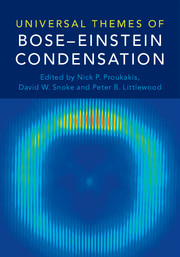Book contents
- Frontmatter
- Contents
- Foreword
- Preface
- Part I Introduction
- Part II General Topics
- Part III Condensates in Atomic Physics
- Part IV Condensates in Condensed Matter Physics
- Editorial Notes
- 19 Bose-Einstein Condensation of Photons and Grand-Canonical Condensate Fluctuations
- 20 Laser Operation and Bose-Einstein Condensation: Analogies and Differences
- 21 Vortices in Resonant Polariton Condensates in Semiconductor Microcavities
- 22 Optical Control of Polariton Condensates
- 23 Disorder, Synchronization, and Phase-locking in Nonequilibrium Bose-Einstein Condensates
- 24 Collective Topological Excitations in 1D Polariton Quantum Fluids
- 25 Microscopic Theory of Bose-Einstein Condensation of Magnons at Room Temperature
- 26 Spintronics and Magnon Bose-Einstein Condensation
- 27 Spin-Superfluidity and Spin-Current Mediated Nonlocal Transport
- 28 Bose-Einstein Condensation in Quantum Magnets
- Part V Condensates in Astrophysics and Cosmology
- Universal Bose-Einstein Condensation Workshop
- Contributors
- Index
- References
22 - Optical Control of Polariton Condensates
from Part IV - Condensates in Condensed Matter Physics
Published online by Cambridge University Press: 18 May 2017
- Frontmatter
- Contents
- Foreword
- Preface
- Part I Introduction
- Part II General Topics
- Part III Condensates in Atomic Physics
- Part IV Condensates in Condensed Matter Physics
- Editorial Notes
- 19 Bose-Einstein Condensation of Photons and Grand-Canonical Condensate Fluctuations
- 20 Laser Operation and Bose-Einstein Condensation: Analogies and Differences
- 21 Vortices in Resonant Polariton Condensates in Semiconductor Microcavities
- 22 Optical Control of Polariton Condensates
- 23 Disorder, Synchronization, and Phase-locking in Nonequilibrium Bose-Einstein Condensates
- 24 Collective Topological Excitations in 1D Polariton Quantum Fluids
- 25 Microscopic Theory of Bose-Einstein Condensation of Magnons at Room Temperature
- 26 Spintronics and Magnon Bose-Einstein Condensation
- 27 Spin-Superfluidity and Spin-Current Mediated Nonlocal Transport
- 28 Bose-Einstein Condensation in Quantum Magnets
- Part V Condensates in Astrophysics and Cosmology
- Universal Bose-Einstein Condensation Workshop
- Contributors
- Index
- References
Summary
Microcavity polaritons, the bosonic quasiparticles resulting from the strong coupling between a cavity photon and a quantum well exciton, offer unique opportunities to study quantum fluids on a semiconductor chip. Their excitonic part leads to strong repulsive polariton–polariton interactions, and their photonic part allows one to probe their properties using conventional imaging and spectroscopy techniques. In this chapter, we report on recent results on the optical manipulation and control of polariton condensates. Using spatially engineered excitation profiles, it is possible to create potential landscapes for the polaritons. This leads to the observation of effects such as long distance spontaneous polariton propagation; confined states in a parabolic potential, in a configuration similar to a quantum harmonic oscillator; and vortex lattices.
Introduction
Wave-particle duality is one of the most striking features of quantum physics and has led to numerous discussions spreading far beyond the field of physics. The fact that the properties of a particle are described by a wavefunction redefined physics between the 19th and 20th centuries. When technological progress started to allow experimental access to microscopic particles, wave effects could be observed. Around the same time, the observation of the photoelectric effect eventually explained by Einstein, introduced the concept of photons, as quanta of electromagnetic radiation [1]. This also forced a reconsideration of the wave theory of light, which at that time was well established thanks to interferometry experiments and Maxwell's equations. Such quantisation in fact linked back to the ideas of light corpuscles as introduced by Newton.
In the 1920s, Einstein, on the basis of Bose's work on the statistics of photons [2], proposed the idea that an atomic gas of noninteracting bosons should exhibit, below a finite temperature, a macroscopic occupation of the lowest energy quantum state [3]. This is what is now called Bose-Einstein condensation and is the main topic of this book. This phenomenon extends the wave properties of matter to an ensemble of particles and therefore to the macroscopic scale. At first, this purely theoretical prediction was first rejected by the scientific community. However, when superfluidity of 4He was observed [4, 5], London proposed that this observation was in fact linked to Bose-Einstein condensation [6]. The situation of liquid helium was however quite far from the picture of a gas of noninteracting particles.
- Type
- Chapter
- Information
- Universal Themes of Bose-Einstein Condensation , pp. 445 - 461Publisher: Cambridge University PressPrint publication year: 2017



